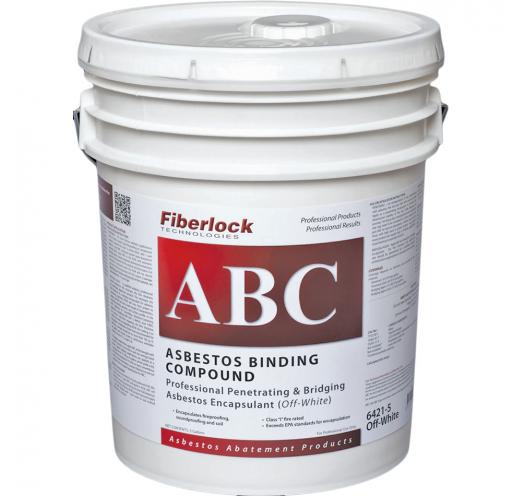Fiberlock ABC Asbestos Binding Compound is a high solids asbestos encapsulant/sealant, designed to encapsulate friable Asbestos Containing Material (ACM) such as fireproofing and insulation material. ABC is an important tool for coping with the health hazards associated with exposure to asbestos fibers. The high solids, nonflammable composition of ABC allows for dilution with water to provide maximum flexibility for specific asbestos abatement needs, including lockdown/removal, penetrating encapsulation and bridging encapsulation. ABC is also an effective tool for controlling the documented health hazard of exposure to asbestos fibers found present in soil.
Features
- Encapsulates fireproofing and soil
- Class A fire rated
- Exceeds EPA standards for encapsulation
- Available in off-white, clear and green
Specifications
- Coverage:Smooth Surfaces 50 - 100 sq. ft. (4 - 9 sq. m) per gallon, Porous Surfaces 50 - 75 sq. ft. (4 - 7 sq. m) per gallon
- Colour: White
- Odour: Very Slight
- Shelf Life: 36 Months Min. (Original Sealed Container)
- Drying Times (@ 70 - 77°F , 50% R.H.): To Touch 1 - 2 hours, To Recoat 12- 24 hours
- Minimum Application Temp: 50°F (10°C)
- pH: 8.5
- Flash Point: Non-combustible
- Viscosity at 70°F: 60-75 Kreb Units
- Calculated VOC: 56-64 grams/liter
- Fire Rating: ASTM E84 Class A
- Package Size: 5 Gallon Pail
- Ready to use: Dependent on application
- Product Number: FLK6421 / 6421-5 / FIB6421-5
Product Application
Application Tools: Professional models of all brands of airless spray equipment can be used to successfully apply ABC. Use the settings below when applying ABC:
- Penetrating: Pressure 1300 - 1400 P.S.I. Tip .017 - .031
- Bridging: Pressure 2200 - 3000 P.S.I. Tip .017 - .023
- Removal/Lockdown: Pressure 2200 - 2300 P.S.I. Tip .015 - .025
Encapsulation Instructions
Penetrant:For most fibrous asbestos applications such as 'cotton candy' style fireproofing or compressed acoustic material less than 2 inches thick, add 1 part water to 1 part ABC. Using the proper spray equipment settings listed, apply ABC to the ACM until saturated. Multiple passes may be required, allowing time between passes for dissipation of the solution into the matrix. Full saturation is achieved when the ACM will not absorb any more of the encapsulant into the matrix. Coverage, depending on thickness and porosity of the material, can vary between 50 - 75 sq. ft./gal.
Bridging Agent: A qualified asbestos professional should determine the necessary dry film thickness for individual abatement projects. The necessary dry film thickness of a bridging encapsulant for asbestos containing materials (ACM) will vary from project to project as ACM can have a wide range of characteristics, including density, porosity, and surface profile. Coverage should be no more than 100 sq. ft. per gallon and should create a continuous, unbroken coating. For bridging applications, apply ABC at full strength with an airless sprayer in accordance with the settings listed below. Typical bridging applications are applied at a coverage rate of 75-100 sq. ft./gallon, which yields a dry film thickness between 6-10 mils on hard, cementitious ACM. For more information, contact Fiberlock or visit our website for the complete Specification for ABC.
Removal / Lockdown: Removal is recommended for loosely adhered ACM. Mix 4 parts water to 1 part ABC and apply to ACM. ABC will facilitate removal by penetrating into the ACM keeping it moist and sticky. After the ACM has been removed, apply 1 part ABC diluted with 1 part water to seal residual fibers left on substrate.
- Dependent on application
No posts found


